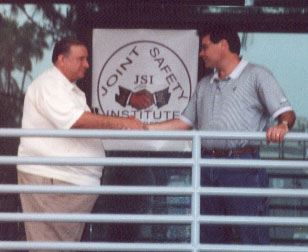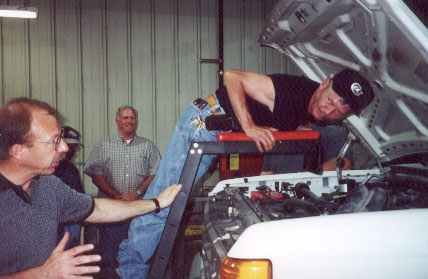Safety training stresses broad ergonomics applications
by Frank Miramontes, Local 18 President and Joint Safety Institute
Administrator
I’ve been meaning to make a proper introduction of my co-administrator,
Chuck Kokoska, who is management’s appointment to the Joint Safety Institute.
Many of you know Chuck from his 20 years with the DWP, starting as a substation
operator in 1981. Later he was an operator at Sylmar Converter Station
and helped start up several stations in the Adelanto district.  He
was a Safety, Training and Environmental Supervisor for Bulk Power, and
for SET (Safety Environmental Training), a combined project of Bulk Power
and Generation. In 1998 he became Superintendent at Sylmar Converting
Station. Many of you have met Chuck recently, as he and I have been visiting
many parts of the system to introduce the new JSI. Chuck brings experience,
ability and dedication to our task: Building a culture of safety in the
DWP by raising safety consciousness to save lives and prevent injuries.
He
was a Safety, Training and Environmental Supervisor for Bulk Power, and
for SET (Safety Environmental Training), a combined project of Bulk Power
and Generation. In 1998 he became Superintendent at Sylmar Converting
Station. Many of you have met Chuck recently, as he and I have been visiting
many parts of the system to introduce the new JSI. Chuck brings experience,
ability and dedication to our task: Building a culture of safety in the
DWP by raising safety consciousness to save lives and prevent injuries.
In May, Chuck and I traveled to Boulder City. We went for a Unit meeting and a Safety Principles and Leadership Skills class. It was a great session with members who work in some of our most challenging environments, subject to extreme heat and wind, where telephone and radio communication is not always reliable.
The training class articulates safety principles and then finds applications in the participants’ daily work. A good example from this workshop is the concept of ergonomics, which Karl (Peak Performance) defines as “taking machines and making them fit around the worker.” After discussing the concept and the types of stress and danger that can be eliminated or minimized by ergonomics, Karl asked the class to come up with examples from their own workplace to show how ergonomics has improved their job. At first everyone drew a blank, but as they thought it over they came up with a number of examples, such as the one pictured here. Before the Department purchased the “topside creeper,” mechanic Gary Hedges worked on high truck engines perched on a stool, necessitating awkward turns and lifts with potential for cumulative damage. Now the work is easier and safer thanks to a small investment in ergonomically designed tools.
The mathematics of the situation are clear: The creeper costs a few
hundred dollars. A workplace injury or disability can cost tens of thousands
of dollars. It PAYS to design a workplace that  eliminates
unnecessary stress and danger. And of course, it’s the right thing to
do. We have the right to have jobs that don’t break us down unnecessarily.
eliminates
unnecessary stress and danger. And of course, it’s the right thing to
do. We have the right to have jobs that don’t break us down unnecessarily.
We have come a long way since one of every two linemen could expect to be killed on the job. But we are not where we need to be. The DWP is still above the industry average for lost-time injuries. We need to improve this. This is the mission of the JSI.
These Safety Training Workshops are designed to help our members think about workplace safety in new terms and come up with ways to make all our jobs safer and better. We don’t expect it to happen overnight, but step by step, idea by idea, observation by observation, we can help fashion a safer work environment, which in the long run will benefit the Department as well as the workers.